de Havilland Canada DHC-4 Caribou
| DHC-4 Caribou | |
|---|---|
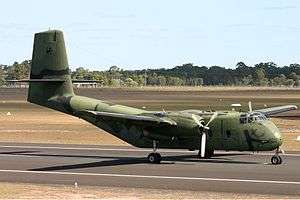 | |
| A Royal Australian Air Force Caribou at Bundaberg airport. | |
| Role | STOL Transport |
| Manufacturer | de Havilland Canada |
| First flight | 30 July 1958 |
| Introduction | 1961 |
| Retired | Royal Australian Air Force (2009) United States Army United States Air Force |
| Status | Retired from military operators, limited service |
| Produced | 1958–1968 |
| Number built | 307 |
| Developed into | de Havilland Canada DHC-5 Buffalo |
The de Havilland Canada DHC-4 Caribou (designated by the United States military as the CV-2 and later C-7 Caribou) is a Canadian-designed and produced specialized cargo aircraft with short takeoff and landing (STOL) capability. The Caribou was first flown in 1958 and although mainly retired from military operations, is still in use in small numbers as a rugged "bush" aircraft.
Design and development
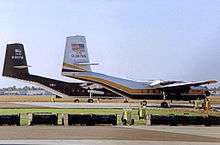

The de Havilland Canada company's third STOL design was a big step up in size compared to its earlier DHC Beaver and DHC Otter, and was the first DHC design powered by two engines. The Caribou, however, was similar in concept in that it was designed as a rugged STOL utility aircraft. The Caribou was primarily a military tactical transport that in commercial service found itself a small niche in cargo hauling. The United States Army ordered 173 in 1959 and took delivery in 1961 under the designation AC-1, which was changed to CV-2 Caribou in 1962.
The majority of Caribou production was destined for military operators, but the type's ruggedness and excellent STOL capabilities requiring runway lengths of only 1200 feet (365 metres)[1] also appealed to some commercial users. U.S. certification was awarded on 23 December 1960. Ansett-MAL, which operated a single example in the New Guinea highlands, and AMOCO Ecuador were early customers, as was Air America, (a CIA front in South East Asia during the Vietnam War era for covert operations). Other civil Caribou aircraft entered commercial service after being retired from their military users.
Today only a handful are in civil use.
Operational history
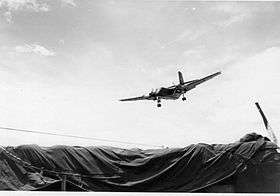
In response to a U.S. Army requirement for a tactical airlifter to supply the battlefront with troops and supplies and evacuate casualties on the return journey, de Havilland Canada designed the DHC-4. With assistance from Canada's Department of Defence Production, DHC built a prototype demonstrator that flew for the first time on 30 July 1958.
Impressed with the DHC4's STOL capabilities and potential, the U.S. Army ordered five for evaluation as YAC-1s and went on to become the largest Caribou operator. The AC-1 designation was changed in 1962 to CV-2, and then C-7 when the U.S. Army's CV-2s were transferred to the U.S. Air Force in 1967. U.S. and Australian Caribou saw extensive service during the Vietnam War.
The U.S. Army purchased 159 of the aircraft and they served their purpose well as a tactical transport during the Vietnam War, where larger cargo aircraft such as the Fairchild C-123 Provider and the Lockheed C-130 Hercules could not land on the shorter landing strips. The aircraft could carry 32 troops or two Jeeps or similar light vehicles. The rear loading ramp could also be used for parachute dropping (also, see Air America).
Under the Johnson-McConnell agreement of 1966, the Army relinquished the fixed wing Caribou to the United States Air Force in exchange for an end to restrictions on Army rotary wing operations. On 1 January 1967, the 17th, 57th, 61st, 92nd, 134th, and 135th Aviation Companies of the U.S. Army were inactivated and their aircraft transferred respectively to the newly activated 537th, 535th, 536th, 459th, 457th, and 458th Troop Carrier Squadrons of the USAF. On 1 August 1967 the "troop carrier" designations were changed to "tactical airlift".
Some U.S. Caribou were captured by North Vietnamese forces and remained in service with that country through to the late 1970s. Following the war in Vietnam, all USAF Caribou were transferred to Air Force Reserve and Air National Guard airlift units pending their replacement by the C-130 Hercules in the 1980s.

All C-7s have now been phased out of U.S. military service, with the last example serving again under U.S. Army control through 1985 in support of the U.S. Army's Golden Knights parachute demonstration team. Other notable military operators included Australia, Brazil, Canada, India, Malaysia and Spain.
The Royal Australian Air Force retired its last Caribou, A4-140, on 27 November 2009.[2] The aircraft, which was manufactured in 1964, was donated to the Australian War Memorial, Canberra.[3]
Civilian operations
After retirement from military use, several examples of the Caribou have been purchased by civilian operators for deployment in areas with small airfields located in rugged country with few or poor surface transport links.
Variants

- DHC-4 Caribou
- STOL tactical transport, utility transport aircraft.
- CC-108
- Royal Canadian Air Force designation for the DHC-4 Caribou.
- YAC-1
- This designation was given to five DHC-4 Caribou, sold to the United States Army for evaluation.
- AC-1
- United States Army designation for the first production run of 56 DHC-4 Caribou. Later redesignated CV-2A in 1962.
- CV-2A
- United States Army AC-1 redesignated in 1962.
- CV-2B
- This designation was given to a second production run of 103 DHC-4 Caribou, which were sold to the U.S. Army, with reinforced internal ribbing.
- C-7A/B
- These designations were applied to all 144 Caribou transferred to the U.S. Air Force by the U.S. Army.
- DHC-4A Caribou
- Similar to the DHC-4, but this version had an increased takeoff weight.
- DHC-4T Turbo Caribou
- A conversion of the baseline DHC-4 Caribou powered by the PWC PT6A-67T turboprop engines designed, test flown and certified by the Pen Turbo Aviation company.
Operators
Military operators
- Abu Dhabi Defence Forces Air Wing – Abu Dhabi operated five Caribou.[4]
- United Arab Emirates Air Force
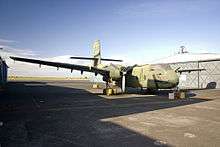
- Royal Australian Air Force – 18 ordered in 1963, with further orders for seven in 1964 and four more aircraft ordered individually between 1968 and 1971.[5] Retired 2009.
- No. 35 Squadron RAAF 1966–2000 – transferred to No 38 Squadron RAAF.[5]
- No. 38 Squadron RAAF 1964–2009 – all retired.[2][5]
- RAAF Transport Flight Vietnam – seven operated from 1964–1971 and returned to Australia 1972 [5]
- Royal Canadian Air Force – nine delivered; retired from Canadian Forces in 1971.[4]
- Cameroon Air Force – two delivered in 1971. The surviving Caribou was sold in 1987.[6]
- Air Surveillance Service – Two ex-USAF C-7As delivered in the 1980s.[6] Refurbished in July 2010 for the Fuerza Publica.[7]
- Ghana Air Force – Ghana acquired eight new-build Caribou in 1963, which were operated until replaced by Fokker F.27-400Ms in 1975.[6]
- Indian Air Force – India received 20 new build Caribou, supplementing them with four ex-Ghanaian Caribou in 1975.[6]

- Imperial Iranian Air Force – One aircraft deliverd to Iran. It was retired after Iran–Iraq War.
- Kenya Air Force – received six DHC-4As, operating the type from 1966–1987.[6][8]
- Kuwait Air Force – received two aircraft in 1963.[9]
- Liberian Army – Two refurbished aircraft were delivered to the Air Reconnaissance Unit in 1989.[10] The aircraft were destroyed during the civil war.

- Malaysian Air Force – retired their Caribou from active service.[11]
- Spanish Air Force – received 12 new Caribou later supplemented by 24 former United States Air Force C-7As.[13] Final retirement 12 June 1991.[14]
- Swedish Air Force – operated one DHC-4 Caribou designated Tp 55 between 1962 and 1965 for evaluation purposes at F 7 Såtenäs Air Force base.[15]
- Royal Thai Police – used three DHC-4A from 1966 to 2005.[16]
- Uganda Police Force Air Wing[17]
- Vietnam People's Air Force – captured several ex-VNAF airplanes.
- Zambian Air Force – operated four Caribou.[18]
Civil operators
- Ansett-MAL – operated one aircraft in the New Guinea highlands.
- La Sarre Air Services
- AMOCO Ecuador
- Anglo-Ecuador Oilfields
- Aerolíneas Cóndor of SA
- New Cal Aviation
- Garamut Exploration Services
- Vanimo Trading
- Air America
- Bannock Aerospace
- Chieftain Air
- Deutsche Aviation
- Environmental Research Institute of Michigan
- Fowler Aeronautical Service
- H A T Aviation Inc.
- John Woods Inc.
- New Cal Aviation
- Pen Turbo Aviation
Aircraft on display
Australia
- Airworthy
- DHC-4 VH-VBA as "A4-210" is owned by the Historical Aircraft Restoration Society, Wollongong, New South Wales. Maintained in airworthy condition and flown regularly at air displays.
- DHC-4 VH-VBB as "A4-234" is owned by the Historical Aircraft Restoration Society, Wollongong, New South Wales. Maintained in airworthy condition and flown regularly at air displays.
- On display
- DHC-4 Caribou A4-140 was gifted to the Australian War Memorial in November 2009.[3]
- DHC-4 Caribou A4-152 was gifted to the Royal Australian Air Force Museum in November 2009.[3]
- DHC-4 Caribou A4-173 at the Queensland Air Museum, Caloundra, Queensland.
- DHC-4 Caribou A4-199 at RAAF Base Townsville, Queensland.
- DHC-4 Caribou A4-236 at RAAF Base Amberley, Queensland.
- DHC-4 Caribou A4-195 at Australian Army Flying Museum, Oakey, Queensland.
India
- On display
- DHC-4 A4-146 at the Indian Air Force Museum, Palam.
- DHC-4 A4-146 at the Indian Air Force Museum, Shillong
Malaysia
- On display
- DHC-4 A4-248 at the Royal Malaysian Air Force Museum, Sungai Besi, Kuala Lumpur.
Spain
- On display
- DHC-4A 371-05 former 37th Transport Wing of SAF at the Museo del Aire (Madrid).
- DHC-4A 37-23 former 37th Transport Wing of SAF at the Villanubla Air Force Base (Valladolid)
United States
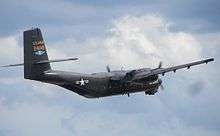
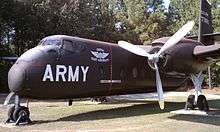

- Airworthy
- CV-2B N149HF (marked as 62-4149) at the Cavanaugh Flight Museum in Dallas, Texas. Fully restored to flying condition.[22]
- On display
- YC-7A 57-3079 at the U.S. Army Transportation Museum, Fort Eustis, Virginia
- YC-7A 57-3080 (tail number 0-73080) at the Army Aviation Museum, Fort Rucker, Alabama.
- YC-7A 57-3083 at the 82nd Airborne Division War Memorial Museum, Fort Bragg, North Carolina.[23]
- C-7A 60-3767 at the Jimmy Doolittle Air & Space Museum, Travis Air Force Base, Fairfield, California.
- C-7A 62-4188 at the New England Air Museum, Bradley International Airport, Connecticut.
- C-7A 62-4193 at the National Museum of the United States Air Force, Wright-Patterson AFB, Ohio.[24]
- C-7B 63-9756 at the Museum of Aviation, Robins AFB, Georgia.
- C-7B 63-9757 at the Hill Aerospace Museum, Hill AFB, Utah.[25]
- C-7A 63-9760 at the Air Mobility Command Museum, Dover AFB, Delaware.
- CV-7B Caribou 63-9719 at the Texas Air & Space Museum in Amarillo, Texas.
- C-7A 63-9765 at Edwards AFB, Air Force Flight Test Center (Last known Caribou delivered to U.S. Army, in U.S. Army Golden Knights markings.
Specifications (DHC-4A)
Data from MacDonald Aircraft Handbook.[26]
General characteristics
- Crew: Three
- Capacity:
- 32 troops or
- 24 fully equipped paratroops or
- 14 casualty stretchers
- Payload: 8,000 lb (3,628 kg)
- Length: 72.58 ft (22.12 m)
- Wingspan: 95.58 ft (29.13 m)
- Height: 31.66 ft (9.65 m)
- Wing area: 912 ft² (84.7 m²)
- Empty weight: 16,920 lb (7,675 kg)
- Loaded weight: 28,500 lb (12,927 kg)
- Powerplant: 2 × Pratt and Whitney R-2000-7M2 Twin Wasp 14-cylinder, 1,450 hp (1,081 kW) each
Performance
- Maximum speed: 216 mph (348 km/h)
- Cruise speed: 181 mph (291 km/h)
- Range: 1,280 mi (2,060 km) (240 mi (390 km) with maximum payload)
- Service ceiling: 24,800 ft (7,559 m)
- Rate of climb: 1,355 ft/min (413 m/min)
The plane takes off within 910 feet (280 m); it lands within 850 feet (260 m).
See also
- Related development
- Aircraft of comparable role, configuration and era
References
Notes
- ↑ "Caribou Sales Brochure – 1962." c-7acaribou.com, 26 May 2011.
- 1 2 "Defence 'workhorse' makes final flight." ABC News, 27 November 2009. Retrieved: 27 November 2009.
- 1 2 3 Fitzgibbon, The Hon. Joel, (MP), Minister for Defence. "Honouring the Caribou's Service to Australia." Department of Defence, 9 March 2009. Retrieved: 9 March 2009.
- 1 2 Henley and Ellis Air Enthusiast March/April 1998, p. 24.
- 1 2 3 4 "A4 DHC-4 Caribou". RAAF Museum Point Cook. 2009. Retrieved 14 April 2012.
- 1 2 3 4 5 Henley and Ellis Air Enthusiast March/April 1998, p. 26.
- ↑ "Fuerza Pública revive avión militar Caribú – SUCESOS – La Nación" (in Spanish). Nacion.com. Retrieved: 26 May 2011.
- ↑ Andrade 1982, p. 141.
- ↑ "Kuwait Air Force (KAF)." Scramble.nl. Retrieved: 26 May 2011.
- ↑ Henley and Ellis Air Enthusiast March/April 1998, pp. 26, 28.
- ↑ "Malaysian Forces Overview." Scramble.nl. Retrieved: 26 May 2011.
- ↑ "Royal Air Force of Oman." Scramble.nl. Retrieved: 26 May 2011.
- ↑ Andrade 1982, p. 204.
- ↑ Soupart Air Enthusiast March–May 1992, p. 47.
- 1 2 Buser, Wayne. "Caribou Roster." Dhc4and5.org, 4 September 2010. Retrieved: 26 May 2011.
- ↑ "Royal Thai Police." fader.dyndns.org. Retrieved: 27 January 2012.
- ↑ Andrade 1982, p. 231.
- ↑ Taylor 1971, p. 19.
- ↑ "VH-BFC. de Havilland DHC-4A Caribou. c/n 23." aussieairliners.org. Retrieved: 18 November 2012.
- ↑ "Serial MSP002 C-7A MSN 149." Scramble.nl. Retrieved: 26 May 2011.
- ↑ "Hore! Setelah Pom Bensin, Kini Kabupaten Puncak Papua Punya Pesawat". detik.com. Retrieved 17 September 2016.
- ↑ "De Havilland CV-2B Caribou." Cavanaugh Flight Museum, 20 June 1963. Retrieved: 18 November 2012.
- ↑ "YAC-1Caribou." dhc4and5.org. Retrieved: 18 November 2012.
- ↑ "Factsheets: de Havilland C-7A Caribou."National Museum of the United States Air Force. Retrieved: 23 August 2015.
- ↑ "Factsheets: C-7B Caribou."Hill Aerospace Museum. Retrieved: 18 November 2012.
- ↑ Green 1964, p. 249.
Bibliography
- Andrade, John. Militair 1982. London: Aviation Press, 1982. ISBN 0-907898-01-7.
- The C-7A Caribou Association
- Caribou Roster deHavilland Caribou (DHC-4) and Buffalo (DHC-5) website.
- "Caribou to Bow Out Early". Air International, Vol. 76. No. 4, April 2009, p. 5.
- Green, William. Macdonald Aircraft Handbook. London: Macdonald & Co. (Publishers) Ltd., 1964.
- Henley, Don and Ken Ellis. "Globetrotting Reindeers: De Havilland Canada's Caribou – an airlift legend". Air Enthusiast, No. 74, March/April 1998, pp. 20–33. ISSN 0143-5450.
- Hotson, Fred W. The de Havilland Canada Story. Toronto: CANAV Books, 1983. ISBN 0-07-549483-3.
- Kuwait Air Force (KAF) entry at the Scramble (magazine) website:
- Malaysian Forces Overview entry at the Scramble magazine website.
- Royal Air Force of Oman entry at the Scramble magazine website.
- Soupart, Roger. "Adios Muchachas!". Air Enthusiast, No. 45, March–May 1992. pp. 44–51. ISSN 0143-5450.
- Taylor, John W.R. (ed.). Jane's All The World's Aircraft 1971–72. London: Janes's Yearbooks, 1971. ISBN 978-0-7106-1262-5.
External links
| Wikimedia Commons has media related to De Havilland Canada DHC-4 Caribou. |
- The C-7A Caribou Association
- "Handling the DHC-4 Caribou" a 1959 Flight article
- "C-7A Operations - 1969 US Air Force Training Film" on YouTube